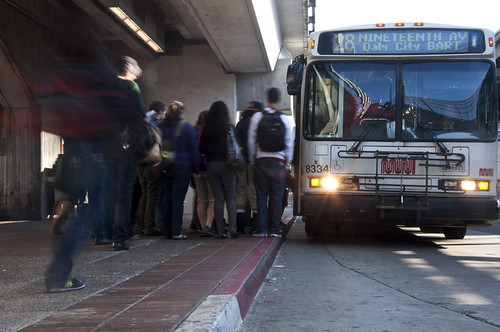
Taking the bus can be a time-consuming process. Waiting for it to arrive and then cramming onto the single front door takes time many students don’t have.
Some hope that this ordeal can be shortened if San Francisco Municipal Transit Agency considers legalizing “back-door boarding” on buses.
Muni officials are currently looking for ways to improve service through the newly-created Transit Effectiveness Project. This project would decrease wait times from 10 percent to 30 percent by increasing the distance between certain stops, allowing back-door boarding and implementing a number of other small changes throughout the system.
While back-door boarding is currently legal on all six light-rail metro lines, riders must board only in front when using buses. The new system would decrease boarding times and increase efficiency.
“I think it’s a great idea,” said SF State junior Bethany Bonnaud, 20. “The worst is when the driver won’t open the back door and everyone who gets on in the front cluster together so some people are left behind at the stop. It makes no sense to me. Why I can’t just swipe my clipper card at the back of the bus. Isn’t it there for a reason?”
Many high volume lines such as the 1-California, 14-Mission, and 38-Geary spend up to 20 percent of their route time at bus stops picking up passengers, according to Muni. The new system would potentially decrease ride times and increase trip efficiency.
The most recent report of Muni on-time performance rates indicates the lines are only on time 72.9 percent of the time. A Muni vehicle is considered on time if it reaches its scheduled destinations between one minute early and four minutes late to its destination according to the official schedule. While a strong argument can be made for opening the back door to increase ride efficiency, the cause for concern lies in fare evasion.
“It sucks that a few bad people ruin it for everyone,” said Muni rider Brandon Harrington, 28. “If everyone just paid their fair share, it wouldn’t even be a question to open the back doors or not.”
The bulk of Muni fare evaders come from people sneaking onto the back of the bus while passengers exit. According to the National Transit Database, San Francisco has the highest hourly bus boarding rates of any United States city at 70 people per bus.
Nearly 10 percent of Muni riders don’t have a valid proof of payment, costing nearly $19 million in missed annual revenue.
“The biggest problem we have with fare evaders is the back door,” said Vivian Meeker, a Muni representative. “This is a delicate situation because while we want to speed up services, we risk an increase in illegal use of the transportation system.”
No decision or recommendation has been made on if the change would be for all the buses, or just a select few during certain hours. There is also the question of security and whether or not there would be any changes made, like having a ticket checker at the back of the bus even though this would add an additional operating expense, which could increase the cost to passengers.



